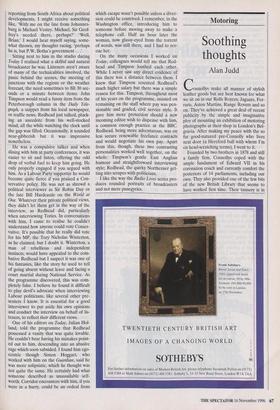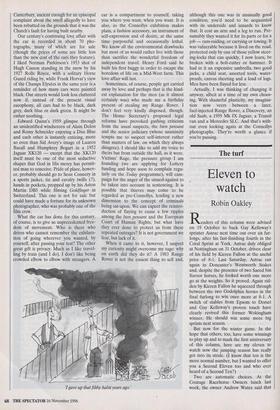Motoring
Soothing thoughts
Alan Judd
Connollys make all manner of stylish leather goods but are best known for what we sit on in our Rolls Royces, Jaguars, Fer- raris, Aston Martins, Range Rovers and so on. They've achieved a great deal of recent publicity by the simple and imaginative ploy of mounting an exhibition of motoring photographs at their shop in London's Bel- gravia. After making my peace with the so far good-natured pre-Connolly who lives next door (a Hereford bull with whom I'm on head-scratching terms), I went to it.
Founded by two brothers in 1878 and still a family firm, Connollys coped with the ample fundament of Edward VII in his coronation coach and currently comfort the posteriors of 14 parliaments, including our own. They also provided one of the few bits of the new British Library that seems to have worked first time. Their tannery is in Canterbury, ancient enough for an episcopal complaint about the smell allegedly to have been rebutted on the grounds that it was the Church's fault for having built nearby.
Our century's continuing love affair with the car is recorded in about 70 pho- tographs, many of which are for sale (though the prices of some are little less than the new cost of the cars they feature). I liked Norman Parkinson's 1953 shot of Hugh Casson standing in the snow by his 1927 Rolls Royce, with a solitary Horse Guard riding by, while Frank Horvat's view of the Champs Elysees in the same year is a reminder of how many cars were painted black. Our streets would look less cluttered now if, instead of the present visual cacophony, all cars had to be black, dark grey, dark blue or dark green. It might be rather soothing.
Edward Quinn's 1959 glimpse through an unidentified windscreen of Alain Delon and Romy Schneider enjoying a Disc Blue and each other is instantly enticing, more so even than Sid Avery's image of Lauren Bacall and Humphrey Bogart in a 1952 Jaguar XK120 — except that the XK120 itself must be one of the most seductive shapes that God in His mercy has permit- ted man to conceive. Pride of place, howev- er, probably should go to Sean Connery in a sports jacket, tie and cavalry twills (?), hands in pockets, propped up by his Aston Martin DB5 while filming Goldfinger in Switzerland. This one is not for sale but could have made a fortune for its unknown photographer, who was probably one of the film crew.
What the car has done for this century, of course, is to give us unprecedented free- dom of movement. Who is there who drives who cannot remember the exhilara- tion of going wherever you wanted, by yourself, after passing your test? The other great gift is privacy. Much as I like travel- ling by train (and I do), I don't like being crowded elbow to elbow with strangers. A car is a compartment to yourself, taking you where you want, when you want. It is also, as the Connollys exhibition makes plain, a fashion accessory, an instrument of self-expression and of desire, at the same time purposeful and occasionally lethal. We know all the environmental drawbacks but most of us would rather live with those than sacrifice the wonderful freedom of independent travel. Henry Ford said he built his first buggy in order to escape the boredom of life on a Mid-West farm. This love affair will last.
Sometimes, of course, people get carried away by love and perhaps that is the kind- est explanation for the men (as it almost certainly was) who made me a birthday present of stealing my Range Rover. I don't feel very kindly disposed, though. The Home Secretary's proposed legal reforms have provoked gushing criticism from the usual suspects, the bien pensant and the senior judiciary (whose unanimity tempts me to suspect self-interest rather than matters of law, on which they always disagree). I should like to add my voice to theirs but from outside the hall, as it were. Victims' Rage, the pressure group I am founding (we are applying for Lottery funding and hope soon to complain regu- larly on the Today programme), will cam- paign for the anger of the sinned-against to be taken into account in sentencing. It is possible that thieves may come to be regarded as pre-Connollys, lending a new dimension to the concept of criminals being sat-upon. We can expect the reintro- duction of flaying to cause a few ripples among the bien pensant and the European Court of Human Rights, but what have they ever done to protect us from these repeated outrages? It is not government we fear, but lack of it.
When it came to it, however, I suspect my curiosity might overcome my rage: why on earth did they do it? A 1983 Range Rover is not the easiest thing to sell and, `I gave up that filthy habit years ago.' although this one was in unusually good condition, you'd need to be acquainted with its underside and innards to know that. It cost an arm and a leg to run. Pre- sumably they wanted it for its parts or for a job — ram-raiding, or carrying or towing. It was vulnerable because it lived on the road, protected only by one of those yellow steer- ing-locks that can quickly, I now learn, be broken with a bolt-cutter or hammer. It had in it an expensive umbrella, two good jacks, a child seat, assorted tools, water- proofs, canvas sheeting and a load of logs. Men have been flayed for less.
Actually, I was thinking of changing it anyway, albeit at a time of my own choos- ing. With shameful plasticity, my imagina- tion now veers between a later, fuel-injected Range Rover, a Discovery, an old Saab, a 1959 Mk IX Jaguar, a Transit van and a Mercedes SLC. And that's with- out even looking again at the Connollys photographs. They're worth a glance if you're passing.



















































































 Previous page
Previous page